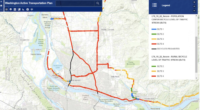"San Francisco and Seattle are both built right on top of rubble from quakes in the early 1900s, and it's all still there. So that's been one of the challenges of this project," Frost says. "There's ship wreckage, moisture and different soil types, so the ground is always changing."
Secant piles reaching 100 ft deep will help create a controlled environment—especially for the first few hundred feet in shallow ground—as the tunnel snakes north under the viaduct, which will be reinforced with carbon-fiber wrap. Bertha will excavate 900,000 cu yd of muck that will be carried out by a 72-in.-wide conveyor belt. Each tunnel ring will have nine concrete liner segments, each 2 ft thick, 20 ft long and 20 tons, plus a key segment. "We hope to build one ring a day to start and move up to six rings," Dixon says. The goal is to excavate about 36 ft a day.
WSDOT and the team developed a rigorous risk-sharing plan, including workshops, a technical advisory team and a risk register. "We identified nine partnering goals and created sub-teams for each of them," says Dixon.



Post a comment to this article
Report Abusive Comment